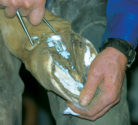Advertise Follow Us
Articles Tagged with ''Thrush''
Dealing with Thrush and White Line Disease
Combining topical treatments with good hoof care will help you keep these common problems under control
Read More
Dealing With Thin-Soled Shoes
Soles get thin for a variety of reasons figuring out which one is the key to treating a case properly
Read More
Shoeing for a Living
Shoeing is His Business, Polo Ponies His Passion
David Manuel finds shoeing these hard-working athletes challenging and rewarding
Read More
Topical Treatments for White Line and Thrush
Everyone seems to have their favorite, but trimming, proper hoof care, seems to be the real key
Read More
Tracking, Treating and Thwarting Thrush
To effectively treat thrush, the farrier sometimes needs to play detective to ferret out the root causes of the bacterial infection
Read More










